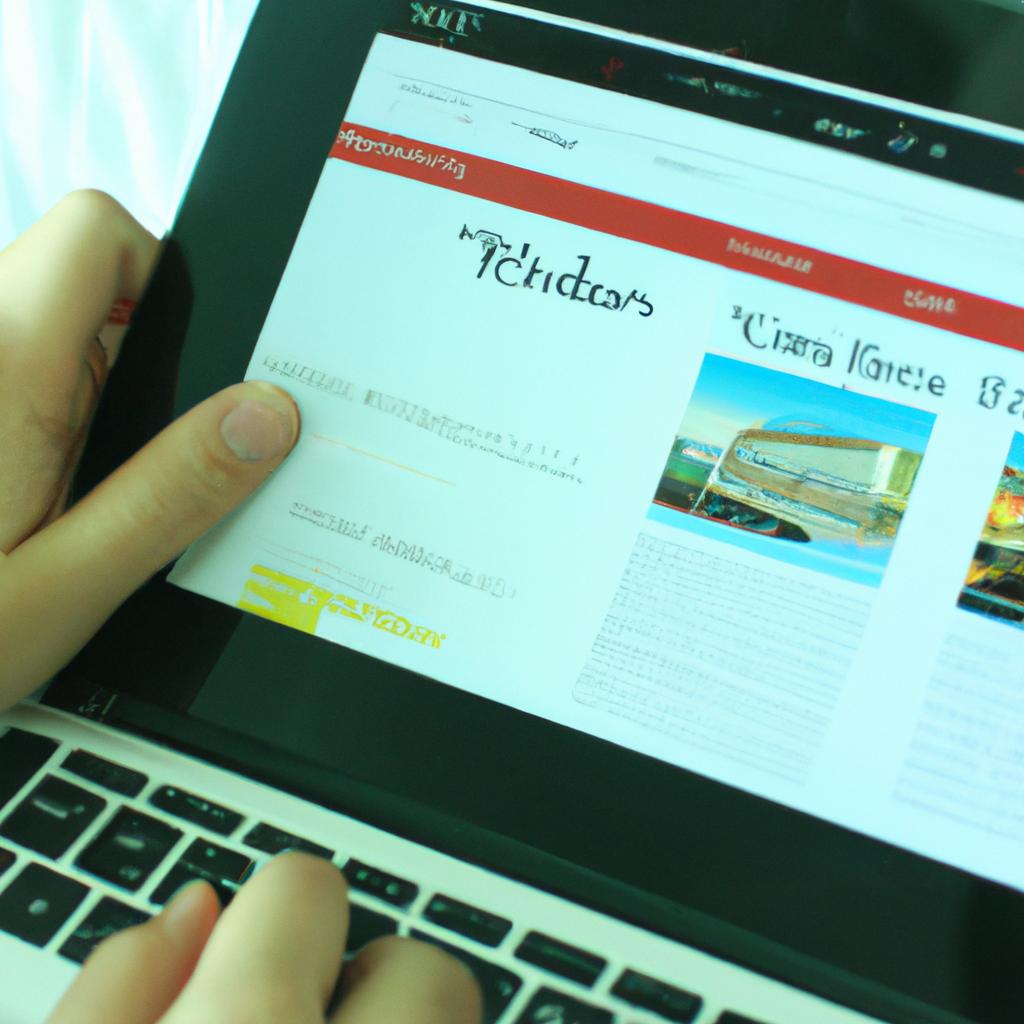The field of user experience design has become increasingly important in today’s digital age, particularly in the realm of hotel web design. As more and more travelers rely on online platforms to research and book their accommodations, hotels are recognizing the need for effective website designs that not only attract visitors but also convert them into customers. This article aims to delve into the concept of conversion rate optimization (CRO) within the context of hotel web design, exploring how it can enhance the overall user experience and ultimately drive higher booking rates.
To illustrate the significance of CRO in hotel web design, let us consider a hypothetical scenario. Imagine a potential traveler planning a vacation who stumbles upon two competing hotel websites during their search. Both websites offer similar amenities, locations, and pricing options; however, one website is designed with meticulous attention to detail and incorporates intuitive navigation elements that guide users seamlessly through the booking process. The other website, on the contrary, appears cluttered and lacks clear calls-to-action or streamlined paths towards completing a reservation. In this case, it is highly likely that our hypothetical traveler will choose the former option due to its superior user experience – an outcome directly influenced by effective conversion rate optimization strategies implemented in its web design.
By examining real-life case studies as well as conducting thorough research and analysis, hotel web designers can identify pain points in the user journey and implement strategic changes to improve conversion rates. For example, they may conduct A/B testing to compare different variations of website elements such as headlines, images, or call-to-action buttons to determine which versions lead to higher conversion rates. They may also analyze user behavior through heatmaps and click-tracking tools to understand where users are dropping off or encountering difficulties in the booking process.
Based on these insights, designers can make data-driven decisions to optimize website layouts, simplify navigation structures, enhance visual aesthetics, and streamline the booking flow. These improvements can range from small adjustments like changing button colors or labels to more significant changes such as redesigning entire sections of the website for better readability and clarity.
In addition to optimizing the design itself, CRO strategies also involve leveraging persuasive techniques such as social proof (e.g., displaying positive customer reviews), scarcity (e.g., showing limited availability), and urgency (e.g., showcasing time-limited offers) to encourage users to take action and complete their bookings.
Ultimately, effective CRO in hotel web design aims to create a seamless and enjoyable user experience that removes any barriers or friction points along the way. This not only increases conversion rates but also fosters customer loyalty by building trust and confidence in the hotel brand.
In conclusion, conversion rate optimization plays a crucial role in the field of hotel web design by enhancing user experience and driving higher booking rates. By applying data-driven insights, conducting thorough analysis, and implementing strategic changes based on user behavior patterns, hotels can create websites that attract visitors and convert them into satisfied customers.
Understanding the User Journey
The user journey is a fundamental aspect of designing an effective hotel website. By understanding how users navigate through the website and what influences their decision-making process, designers can optimize conversion rates and enhance overall user experience. To illustrate this concept, let’s consider a hypothetical scenario involving a traveler searching for accommodation in a new city.
Upon landing on the hotel website, the user is presented with various options and features designed to guide them towards making a booking. The first step in understanding the user journey is recognizing that it typically begins with initial research or inspiration. Users might have specific criteria or preferences in mind, such as location, amenities, or price range. They may also be influenced by external factors like recommendations from friends or online reviews.
Once users have identified potential hotels based on their initial research, they will proceed to evaluate these options further. During this stage of the user journey, elements such as clear and intuitive navigation menus, informative descriptions of rooms and facilities, high-quality images, and positive customer testimonials play crucial roles in helping users make informed decisions.
To evoke an emotional response from users at this critical stage of evaluation, designers can incorporate certain strategies:
- Highlighting special offers or exclusive discounts
- Showcasing personalized experiences tailored to different types of travelers (e.g., family-friendly activities for those traveling with children)
- Providing interactive tools like virtual tours or 360-degree room views
- Offering social proof through real-time availability updates or displaying recent bookings made by other guests.
Additionally, presenting information in a visually appealing manner can greatly impact user engagement. A three-column table summarizing key features such as room size, included amenities, and pricing could help users compare options efficiently while evoking trust and credibility.
In conclusion,
By understanding the user journey within the context of hotel web design, designers can effectively optimize conversion rates by providing relevant information and facilitating seamless navigation throughout the website.
Identifying Pain Points in the Booking Process
Understanding the User Journey is crucial for optimizing conversion rates in hotel web design. By analyzing how users navigate through a website, designers can identify pain points and make necessary improvements to enhance user experience. This section will delve deeper into identifying these pain points in the booking process.
To illustrate this point, let’s consider a hypothetical case study of a luxury hotel website. During an analysis of their user journey, it was discovered that many potential guests abandoned their bookings during the payment stage. Further investigation revealed several common pain points that contributed to this issue:
- Complex Payment Process: Users found the payment process confusing and time-consuming, leading to frustration and ultimately abandonment.
- Lack of Trust Indicators: The absence of trust indicators, such as security badges or customer testimonials, made users hesitant about providing personal information.
- Loading Speed Issues: Slow loading times during the checkout process discouraged users from completing their bookings.
- Unclear Cancellation Policies: Users were uncertain about cancellation policies and felt apprehensive about committing to a reservation without clear guidelines.
Addressing these pain points is essential for increasing conversion rates on hotel websites. To effectively optimize the user experience, here are some strategies that can be employed:
- Simplify the payment process by reducing steps and clearly indicating progress.
- Display trust indicators prominently throughout the booking flow to instill confidence in users.
- Optimize website speed by compressing images and minimizing server response time.
- Provide detailed and transparent cancellation policies upfront to alleviate any concerns.
By implementing these strategies, hotels can improve user satisfaction and increase conversions on their websites.
Optimizing Website Navigation and Layout
Now, let us delve into another crucial aspect of user experience design in hotel web design: optimizing website navigation and layout.
To illustrate this point, consider a hypothetical scenario where a potential guest visits a hotel’s website with the intention to book a room. As they navigate through the site, they encounter multiple hurdles that impede their progress. The menu structure is convoluted, making it difficult for them to find essential information such as room rates or availability. Additionally, the booking form is lengthy and requires excessive personal details, leading to frustration and abandonment of the reservation process.
To streamline website navigation and layout effectively, here are key strategies to consider:
-
Simplify Menu Structure:
- Reduce clutter by organizing menu items logically.
- Use clear labels and avoid jargon.
- Prioritize important sections like room types, amenities, and special offers.
-
Enhance Visual Hierarchy:
- Utilize visual cues such as color contrast or typography to guide users’ attention.
- Highlight critical information such as pricing or limited-time promotions.
-
Optimize Website Speed:
- Minimize loading times by compressing images and files.
- Implement caching techniques to enhance performance.
-
Ensure Mobile Responsiveness:
- Design your website responsively for seamless usability across devices.
- Adapt layouts based on screen size while maintaining consistency in content presentation.
Consider the following table illustrating how streamlining these aspects can positively impact conversion rates:
| Improved Aspect | Conversion Rate Impact |
|---|---|
| Simplified Menu Structure | Easier navigation leads to higher conversions |
| Enhanced Visual Hierarchy | Clear information hierarchy boosts user engagement |
| Optimized Website Speed | Faster load times reduce bounce rate |
| Mobile Responsiveness | Better mobile experience increases bookings |
By implementing these strategies, hotel websites can significantly enhance the user experience and increase conversion rates. In our next section, we will discuss further optimization techniques by streamlining the booking form.
Streamlining the Booking Form
When it comes to user experience design in hotel web design, optimizing website navigation and layout plays a crucial role in enhancing the overall usability of the site. By ensuring that users can easily find what they are looking for and navigate through the different sections seamlessly, hotels can significantly improve their conversion rates. For instance, let’s consider a hypothetical case study of Hotel A. Prior to making any changes to their website navigation and layout, users often struggled to locate essential information such as room types, amenities, or contact details. As a result, the bounce rate was high, leading to lower conversions.
To address this issue and enhance user experience, several strategies can be implemented:
- Clear Menu Structure: The website should have a clear menu structure with intuitive labels that accurately represent each section. This helps visitors easily understand where they need to go to find specific information.
- Consistent Design Elements: Employing consistent design elements throughout the website creates familiarity and improves usability. Users should be able to recognize buttons, links, and other interactive elements without confusion.
- Responsive Design: With an increasing number of users accessing websites from mobile devices, it is vital that hotel websites are optimized for various screen sizes. Implementing responsive design ensures a seamless experience across all devices.
- Prominent Call-to-Action Buttons: Placing prominent call-to-action buttons strategically on key pages encourages users to take desired actions such as booking a room or contacting the hotel directly.
Table 1 below illustrates how implementing these strategies helped Hotel A improve its conversion rates:
| Strategy | Before Implementation | After Implementation |
|---|---|---|
| Clear Menu Structure | Difficult to Navigate | Intuitive Navigation |
| Consistent Design | Inconsistent Look | Unified User Interface |
| Responsive Design | Limited Mobile Support | Seamless Experience Across Devices |
| Prominent CTA Buttons | Hidden or Inconspicuous | Easily Accessible and Eye-catching |
By optimizing website navigation and layout using these strategies, Hotel A witnessed a significant decrease in bounce rates and an increase in conversion rates. The user-friendly design allowed visitors to easily find information they were seeking, leading to more bookings and improved customer satisfaction.
Transitioning into the next section about “Leveraging Social Proof and Testimonials,” it is essential for hotel websites to not only have well-designed navigation but also utilize social proof elements effectively.
Leveraging Social Proof and Testimonials
Transitioning from the previous section on streamlining the booking form, it is important to highlight another effective strategy in hotel web design for optimizing conversion rates – leveraging social proof and testimonials. By incorporating social proof elements into the website, hotels can build trust with potential guests, increase credibility, and ultimately improve their chances of converting visitors into customers.
One example of effectively leveraging social proof is by displaying positive customer testimonials prominently on the website. These testimonials can provide real-life examples of satisfied guests who have had a positive experience at the hotel. For instance, let’s consider a hypothetical case study where a luxury resort implemented this strategy by creating a dedicated page showcasing authentic guest reviews alongside photos and personal stories. This not only enhances the credibility of the hotel but also creates an emotional connection with potential guests.
To further emphasize the impact of leveraging social proof and testimonials, here are some key reasons why it is crucial for hotel websites:
- Establishes Trust: Displaying positive reviews from past guests helps establish trust as potential customers see that others have had positive experiences.
- Increases Credibility: Social proof acts as validation for your claims about exceptional service or facilities, increasing credibility among potential guests.
- Influences Decision-Making: Seeing favorable reviews can sway hesitant visitors towards making a reservation.
- Builds Emotional Connection: Personal stories shared through testimonials evoke emotions in readers, fostering a sense of relatability.
In addition to testimonials, hotels can also utilize other forms of social proof like awards won or endorsements from industry experts. Creating a visually appealing table (as shown below) comparing accolades received can help reinforce the reputation and desirability of the hotel.
| Award Name | Year | Category |
|---|---|---|
| Best Luxury Resort | 2020 | Accommodation |
| Excellence in Service | 2019 | Customer Service |
| Top Spa Retreat | 2018 | Wellness & Relaxation |
| Fine Dining Award | 2017 | Culinary Experience |
By leveraging social proof and testimonials effectively, hotels can significantly enhance their website’s user experience and conversion rates. The next section will delve into another important technique for continuous improvement – implementing A/B testing.
“To ensure ongoing optimization of your hotel website, it is essential to implement A/B testing as a methodical approach towards improving its performance.”
Implementing A/B Testing for Continuous Improvement
Transition from Previous Section
Having explored the significance of leveraging social proof and testimonials in hotel web design, we now turn our attention to another crucial aspect: implementing A/B testing for continuous improvement. By employing this method, hotels can optimize their websites and enhance user experience, ultimately leading to higher conversion rates.
Implementing A/B Testing for Continuous Improvement
A/B testing involves comparing two versions of a webpage or interface element to determine which performs better in achieving specific objectives. This method allows hotels to make data-driven decisions by systematically varying elements on their website and measuring the impact on user behavior. Let us consider an example to illustrate its effectiveness:
Case Study Example: A luxury hotel chain decides to conduct an A/B test on their reservation page. They create two variations: Version A with a traditional layout featuring all necessary information at once, and Version B with a simplified design that requires users to click through different steps for booking confirmation. By tracking metrics such as bounce rate, time spent on page, and conversion rate, they discover that Version B outperforms Version A significantly in terms of conversions.
To successfully implement A/B testing and drive meaningful improvements in user experience design, hotels should keep several key considerations in mind:
- Define clear goals: Clearly articulate what aspects of your website you want to improve (e.g., increasing conversions, reducing cart abandonment) before starting the test.
- Identify variables: Determine which elements you want to compare between the control version and the variation(s). These could include headlines, call-to-action buttons, images, layouts, or even entire landing pages.
- Segmentation: Segment your audience based on relevant criteria such as demographics or browsing behaviors. This allows for more targeted analysis of results and helps uncover patterns among specific groups.
- Statistical Significance: Ensure that your sample size is large enough so that any observed differences are statistically significant. Tools like Google Optimize or Optimizely can help calculate the necessary sample size.
To further illustrate the potential impact of A/B testing, consider the following table:
| Element | Variation A | Variation B |
|---|---|---|
| Headline | “Book Now!” | “Find Your Perfect Getaway” |
| CTA Button | Red | Blue |
| Image | Beach Resort | Cityscape |
| Layout | Traditional | Modern |
By comparing these variations through A/B testing and analyzing relevant metrics, hotels can make informed design decisions that resonate with their target audience. This iterative approach allows for continuous improvement in user experience and ultimately leads to higher conversion rates.
In summary, implementing A/B testing offers hotels a data-driven methodology to optimize their websites continuously. By clearly defining goals, identifying variables, segmenting audiences, and ensuring statistical significance, hoteliers can uncover valuable insights into user behavior and preferences. Through this process of experimentation and refinement, hotels can create more engaging digital experiences that lead to improved conversion rates.




